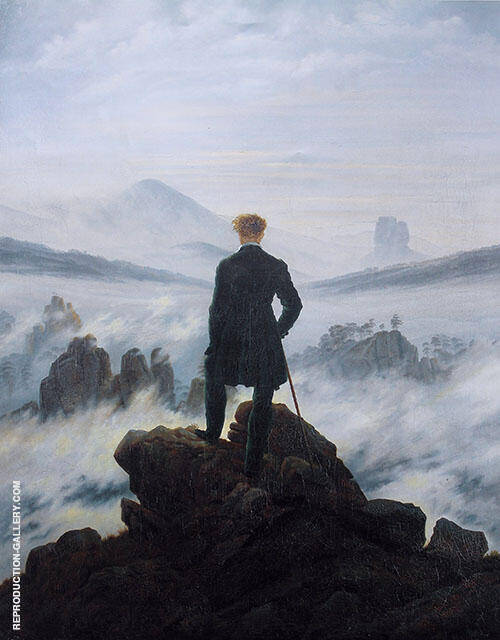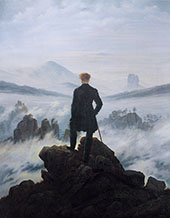Wanderer Above the Sea of Fog 1818 By Caspar David Friedrich
Wanderer Above the Sea of Fog by Caspar David Friedrich
Casper David Friedrich Wanderer Above the Sea of Fog 1818 is a masterpiece of the Romanticism Art Movement. Other famous artists of the Romantic period include Francisco Goya and J.M.W. Turner
As one of the most famous German painters, Caspar David Friedrich paintings depict allegorical landscapes and motionless contemplative figures.
Why is Wanderer Above the Sea of Fog Mysterious?
Wanderer Above the Sea of Fog presents a fashionable gentleman, cane in hand, standing and gazing into a misty valley. Vague mountains and rolling hills are visible in the background, while trees and rocky outcrops emerge from the middle distance. The fog-covered landscape drifts off indefinitely away from the viewer, eventually indistinguishable from the horizon.
The man’s position (with his back to the viewer) adds to the mystery of the painting. His emotions and facial expressions remain something purely created by our imagination. He wears a dark jewel-green coat to protect against the mountain wind. His stance suggests confidence and physicality, yet there’s an indisputable melancholy to the piece.
A Masterpiece of Romantic Landscape Painting
Today, Wanderer Above the Sea of Fog exemplifies the Romantic movement. Romantic paintings prioritize exploring emotional responses over direct representation. Indeed, Caspar David Friedrich’s ostensibly “realistic” scene is an amalgamation of components.
Scholars identify geology from the Elbe Sandstone Mountains stretching across Saxony and Bohemia. Friedrich often sketched “en plein air” but then rearranged his drawings in the studio. Only once he was happy with the overall composition did he begin to paint.
Identifiable features include the Zirkelstein (a striking 40-meter sandstone table hill in Saxony) and the heavily weathered Kaiserkrone on which the man stands. Along with the Zirkelstein, this table hill rises from the low-lying Schöna valley. It is this particular geography that explains the intensely foggy scene. The mountains in the background are either the Kaltenberg or the Rosenberg peaks, although debates rage about their exact geographic identity.
Romantic landscape painting mainly explored man’s relationship with nature and our ongoing conflict with the natural world (and ourselves). It was partly a reaction to the emergence of the Industrial Revolution and followed the Age of Enlightenment.
In an age of rapidly expanding cities, production lines, and gray factories, the Romantics were revolutionary in their rejection of capitalist logic. Their work also firmly rejected the previous Neoclassicism art rules of strict compositional harmony and balance.
Wanderer Above the Sea of Fog Meaning
Subjectivity and individuality were the watchwords of the Romantics. Evidenced throughout practically all of Caspar David Friedrich's artworks, these ideas fundamentally inspired the artist. Wanderer Above the Sea of Fog is particularly representative, however, seen as an icon of philosophical and existential self-reflection. Akin to Socrates’ famous maxim “know thyself,” critics praise the painting for its intense contemplative nature.
Speaking of his art, Friedrich said an artist should paint “what he sees inside himself.” For Friedrich, this was of equal importance to figurative representation. Modern art historians (such as Christopher John Murray) agree with this interpretation. Murray notes how Caspar David Friedrich paintings push our “gaze” towards their “metaphysical dimension.”
As well as its influence on the art world, Wanderer Above the Sea of Fog has shaped modern conceptions of travel, exploration, and mountain climbing. It promotes ideals of lone visionaries and explorers, boldly treading new paths and ideas. Indeed, the idea that standing at the peak of a mountain was anything to be celebrated was a revolutionary concept in itself. Yet, up until this point, the climber-hero ideal hadn’t existed.
The painting currently hangs in the Hamburger Kunsthalle, an art museum in Hamburg, Germany.
Enjoy the charm of Caspar David Friedrich paintings and buy reproduction oil paintings from our extensive online catalog.
Famous painting replicas are available in many sizes and are all 100% hand painted by one of our resident professional artists.
We offer a 100% money back guarantee or replacement service. If for any reason you are dissatisfied with your painting please contact us within 7 days of receipt, advising the reason you are unhappy and we will provide you with all the information you need for its return or replacement.
We ship free to anywhere in the world via FedEx or DHL expedited service with online tracking.
Your painting will be shipped rolled in strong plastic tubing, ready for stretching and/or framing locally. This is the conventional method of transporting hand-painted oil on canvas. Learn more about how your painting is shipped.
We are able to offer a framing service intercontinental U.S. Please contact us if you would like a quotation. Alternatively, should you prefer, we can recommend a framer in your area.
Notes About Your Painting
Please note that replica oil paintings are finished with an additional 10cm (4") of extra canvas on all sides, allowing ample surplus canvas for stretching and framing.
Recently Viewed:
Cannot Find What You Are Looking For?
Reproduction Gallery Information
Customer Service
(Send Us A Message)
Tel: (503) 937 2010
Fax: (503) 937 2011







